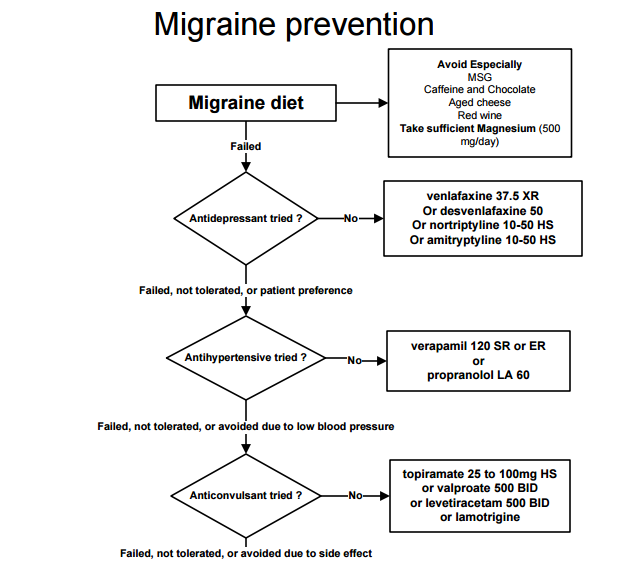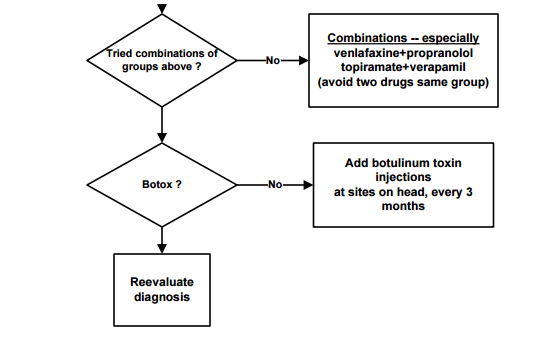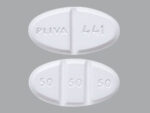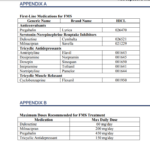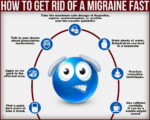Migraine is a “committee disease”, with multiple genetic variants. It seems extremely likely that there is no single drug that will “work” in this collection of several disorders that share some common features.

In other words, prevention of migraine is a “trial and error” process.
There are several types of migraines, including:
- Migraine without aura: This is the most common type of migraine, accounting for about 70-90% of cases. It is characterized by moderate to severe pulsating or throbbing pain on one side of the head, often accompanied by nausea, vomiting, and sensitivity to light and sound.
- Migraine with aura: This type of migraine is characterized by visual disturbances, such as flashing lights, zigzag lines, or blind spots, that typically occur before the onset of the headache. Aura symptoms usually last between 5 and 60 minutes and are followed by the headache.
- Chronic migraine: This is a type of migraine that occurs on 15 or more days per month for at least three months, with at least eight of those days being migraine attacks.
- Vestibular migraine: This type of migraine is characterized by dizziness or vertigo, often accompanied by nausea and difficulty with balance.
- Hemiplegic migraine: This is a rare type of migraine that can cause temporary paralysis or weakness on one side of the body, often mimicking a stroke.
- Menstrual migraine: This type of migraine is linked to hormonal changes during the menstrual cycle and tends to occur just before or during menstruation.
- Ocular migraine: This is a type of migraine that affects the vision, causing temporary visual disturbances or even temporary vision loss in one eye.
- It’s important to note that there is some overlap between these types, and some people may experience multiple types of migraines. It’s also possible for migraine symptoms to change over time.
For those who have more than 2 severe headaches/month and in patients with complicated migraine (migraine with stroke-like features), a daily medication may be worth while. These are generally highly effective (about 75% effective), but do require daily regular use.
Only about 3-5% of migraine patients use prevention medications, according to Gray (1999).
These drugs fall into four major classes:
- anticonvulsants,
- antidepressants,
- antihypertensives,
Examples are: Amitriptyline (Elavil), Botox, Depakote and Topiramate, Inderal, Nardil and Venlafaxine, Verapamil (Calan, Isoptin).
These drugs seem to work via several pathways: some are beta-blockers (e.g. Inderal, Corguard), some are calcium channel blockers (e.g. verapamil). Some work on electrical activity in the brain(e.g. topiramate). Some in mysterious ways, possibly through manipulations of serotonin(e.g. Nardil, amitriptyline, venlafaxine). More information about these is in the next section.
Migraine is a “committee disease”, with multiple genetic variants. It seems extremely likely that there is no single drug that will “work” in this collection of several disorders that share some common features. In other words, prevention of migraine is a “trial and error” process.
To use these drugs it is best to have a measure of effect.
One way is to use a headache diary. Here we recommend a month/page style format, and a stoplight; color code – – red bad, yellow — fair, green good. Another is to do it online
Our approach to migraine prevention and use of these drugs can be found by clicking on the flowchart above.
We also can point the reader to an extensive online review published in 1999 by a US government agency, and found on the NCBI bookshelf. Although it is extremely dated (i.e. somebody should put out a newer edition), it still summarizes an immense amount of data.
Migraine headache relief can be achieved through a combination of lifestyle changes, medications, and natural remedies.
Here are some strategies that might help:
Medications
- Over-the-counter (OTC) pain relievers: Ibuprofen, aspirin, and acetaminophen can provide relief for mild migraines.
- Prescription medications:
- Triptans: Medications like sumatriptan and rizatriptan are specifically for migraines.
- Ergots: Dihydroergotamine can help with pain.
- Anti-nausea medications: These can be useful if migraines are accompanied by nausea.
- Preventive medications: Beta-blockers, antidepressants, anticonvulsants, and CGRP inhibitors can help reduce the frequency of migraines.
Lifestyle and Home Remedies
- Maintain a regular sleep schedule: Ensure you get adequate sleep each night.
- Stay hydrated: Drink plenty of water throughout the day.
- Dietary changes: Avoid known triggers such as caffeine, alcohol, and certain foods like aged cheese and processed meats.
- Regular exercise: Engage in moderate physical activity regularly.
- Manage stress: Practice relaxation techniques such as yoga, meditation, and deep breathing exercises.
- Caffeine: In small amounts, caffeine can help reduce migraine pain, but be cautious as it can also trigger migraines.
Natural Remedies
- Butterbur and feverfew: Some supplements have been shown to reduce migraine frequency.
- Magnesium: Supplementing with magnesium may help, especially if you have a deficiency.
- Riboflavin (Vitamin B2): High doses of riboflavin can reduce the frequency and duration of migraines.
- Acupuncture: This traditional Chinese practice has shown effectiveness for some people in reducing migraines.
- Essential oils: Lavender and peppermint oil can provide relief when applied to the temples or through aromatherapy.
Other Strategies
- Biofeedback: This technique helps you control physiological functions like muscle tension and heart rate, potentially reducing migraine symptoms.
- Cognitive-behavioral therapy (CBT): CBT can help you manage stress and develop coping strategies for migraine pain.
When to See a Doctor
- If migraines are frequent or severe
- If OTC medications are not effective
- If you experience new or different symptoms
Always consult with a healthcare professional before starting any new treatment, especially if you have other health conditions or are taking other medications.
Natural Remedies for Migraine Headache
Natural remedies can be an effective way to manage migraine headaches. Here are several options to consider:
Herbal Supplements
- Butterbur: Some studies suggest that butterbur root extract can reduce the frequency of migraines. Ensure you use a purified form to avoid liver toxicity.
- Feverfew: Feverfew may help prevent migraines and reduce their severity.
Vitamins and Minerals
- Magnesium: Low levels of magnesium are linked to migraines. Magnesium supplements may help, especially for those with a deficiency.
- Riboflavin (Vitamin B2): High doses of riboflavin have been shown to reduce migraine frequency and duration.
- Coenzyme Q10 (CoQ10): This supplement may reduce the frequency of migraines.
Essential Oils
- Peppermint Oil: Applying diluted peppermint oil to the temples can provide cooling relief and reduce headache pain.
- Lavender Oil: Inhaling lavender essential oil or applying it diluted to the temples may help alleviate migraine symptoms.
Acupuncture
This traditional Chinese practice involves inserting thin needles into specific points on the body. Some studies suggest that acupuncture can reduce the frequency and intensity of migraines.
Biofeedback
This technique involves learning to control physiological functions such as muscle tension and heart rate. Biofeedback can help reduce the occurrence and severity of migraines by managing stress and promoting relaxation.
Dietary Changes
- Identify and avoid triggers: Common triggers include caffeine, alcohol, aged cheeses, and processed meats.
- Maintain a regular eating schedule: Avoid skipping meals, as irregular eating can trigger migraines.
Lifestyle Adjustments
- Regular Exercise: Moderate, regular exercise can reduce stress and improve overall well-being, potentially reducing migraine frequency.
- Stress Management: Techniques such as yoga, meditation, and deep breathing exercises can help manage stress, a common migraine trigger.
- Adequate Sleep: Maintain a regular sleep schedule and ensure you get sufficient rest.
Hydration
Dehydration can trigger migraines. Ensure you drink enough water throughout the day to stay well-hydrated.
Cold Compress
Applying a cold or ice pack to the forehead or neck can help constrict blood vessels and reduce inflammation, providing relief from migraine pain.
Caffeine
In small amounts, caffeine can help reduce migraine pain. However, excessive consumption can lead to dependence and trigger migraines, so use it cautiously.
Ginger
Ginger has anti-inflammatory properties and can help reduce migraine symptoms. It can be consumed as a tea or in supplement form.
It’s important to consult with a healthcare professional before starting any new treatment, especially if you have other health conditions or are taking medications. Natural remedies can be a part of a comprehensive approach to managing migraines.
Medications for Migraine Headache
Medications for migraine headaches can be categorized into two main types: those that provide relief during an attack (acute or abortive treatments) and those that help prevent future attacks (preventive treatments). Here is an overview of commonly used medications in both categories:
Acute (Abortive) Treatments
These medications are taken at the onset of migraine symptoms to relieve pain and other symptoms.
- Over-the-counter (OTC) Pain Relievers:
- Aspirin: Can relieve mild to moderate migraine pain.
- Ibuprofen (Advil, Motrin): Effective for mild to moderate migraines.
- Acetaminophen (Tylenol): Can be used alone or in combination with other medications.
- Combination Medications: Excedrin Migraine combines aspirin, acetaminophen, and caffeine.
- Triptans:
- Sumatriptan (Imitrex): Commonly used to treat acute migraines.
- Rizatriptan (Maxalt): Effective for relieving migraine pain.
- Zolmitriptan (Zomig): Available in tablet, nasal spray, and dissolvable tablet forms.
- Naratriptan (Amerge): Longer-acting triptan for sustained relief.
- Eletriptan (Relpax): Fast-acting triptan.
- Ergotamines:
- Dihydroergotamine (DHE 45, Migranal): Available as an injection or nasal spray.
- Ergotamine and Caffeine (Cafergot): Can be effective but has more side effects than triptans.
- Anti-nausea Medications:
- Metoclopramide (Reglan): Helps with nausea and enhances absorption of pain medications.
- Prochlorperazine (Compazine): Used to treat nausea associated with migraines.
- CGRP Receptor Antagonists:
- Ubrogepant (Ubrelvy): An oral medication for acute migraine relief.
- Rimegepant (Nurtec ODT): Can be used for acute treatment and prevention of migraines.
How to Prevent Migraine ?
There are several strategies that can help prevent migraines or reduce their frequency and severity:
- Identify triggers: Keep a migraine diary to track your symptoms and identify any triggers that may be causing your migraines. Common triggers include stress, lack of sleep, certain foods or drinks, hormonal changes, and environmental factors such as bright lights or strong smells.
- Make lifestyle changes: Making healthy lifestyle changes can help reduce the frequency and severity of migraines. This can include getting regular exercise, practicing stress-reducing techniques such as meditation or yoga, and maintaining a consistent sleep schedule.
- Avoid trigger foods: Certain foods and drinks can trigger migraines in some people. Common triggers include caffeine, alcohol, chocolate, aged cheeses, and foods containing MSG or nitrates.
- Take preventive medication: There are several medications that can be taken daily to help prevent migraines. These include beta-blockers, antidepressants, anticonvulsants, and CGRP inhibitors.
- Use acute treatment: Over-the-counter pain relievers such as aspirin, ibuprofen, and acetaminophen can be effective for treating mild to moderate migraines. Prescription medications such as triptans or ergotamines may be necessary for more severe migraines.
- Consider alternative therapies: Certain alternative therapies, such as acupuncture, biofeedback, or massage, may be helpful in reducing migraine symptoms for some people.
It’s important to work with a healthcare provider to develop a personalized migraine prevention plan that takes into account your individual triggers and symptoms.
Prevent Medicines for Migraines
There are several preventive medications available for migraines that can be effective in reducing the frequency, severity, and duration of migraines. These medications are taken regularly to reduce the frequency, severity, and duration of migraines.
- Beta-Blockers:
- Propranolol (Inderal): Commonly used to prevent migraines.
- Metoprolol (Lopressor, Toprol): Effective for some patients.
- Antidepressants:
- Amitriptyline (Elavil): A tricyclic antidepressant that can help prevent migraines.
- Venlafaxine (Effexor): An SNRI that may be effective for migraine prevention.
- Anticonvulsants:
- Topiramate (Topamax): Effective for preventing migraines.
- Valproate (Depakote): Another option for migraine prevention.
- CGRP Inhibitors:
- Erenumab (Aimovig): A monthly injection that targets the CGRP pathway.
- Fremanezumab (Ajovy): Another CGRP inhibitor available as a monthly or quarterly injection.
- Galcanezumab (Emgality): Monthly injection for migraine prevention.
- Botox (OnabotulinumtoxinA):
- Botox Injections: Used for chronic migraine prevention in adults who experience headaches on 15 or more days per month.
It’s important to work with a healthcare provider to determine which preventive medication is right for you, as the effectiveness and side effects of these medications can vary from person to person. In addition, it may take several weeks or even months to determine if a particular medication is effective in preventing migraines.
Combination Therapies
Sometimes, a combination of medications is more effective than a single treatment. This can include a mix of acute and preventive treatments tailored to the individual’s needs.
Non-Pharmacological Approaches
In addition to medications, non-pharmacological approaches such as cognitive-behavioral therapy (CBT), biofeedback, acupuncture, and lifestyle changes (diet, exercise, stress management) can complement medical treatments and provide additional relief.
Always consult with a healthcare professional before starting or changing any medication regimen for migraines, as they can help determine the most appropriate treatment based on individual needs and medical history.
Pain Medications, Pain Relief, and Pain Management
